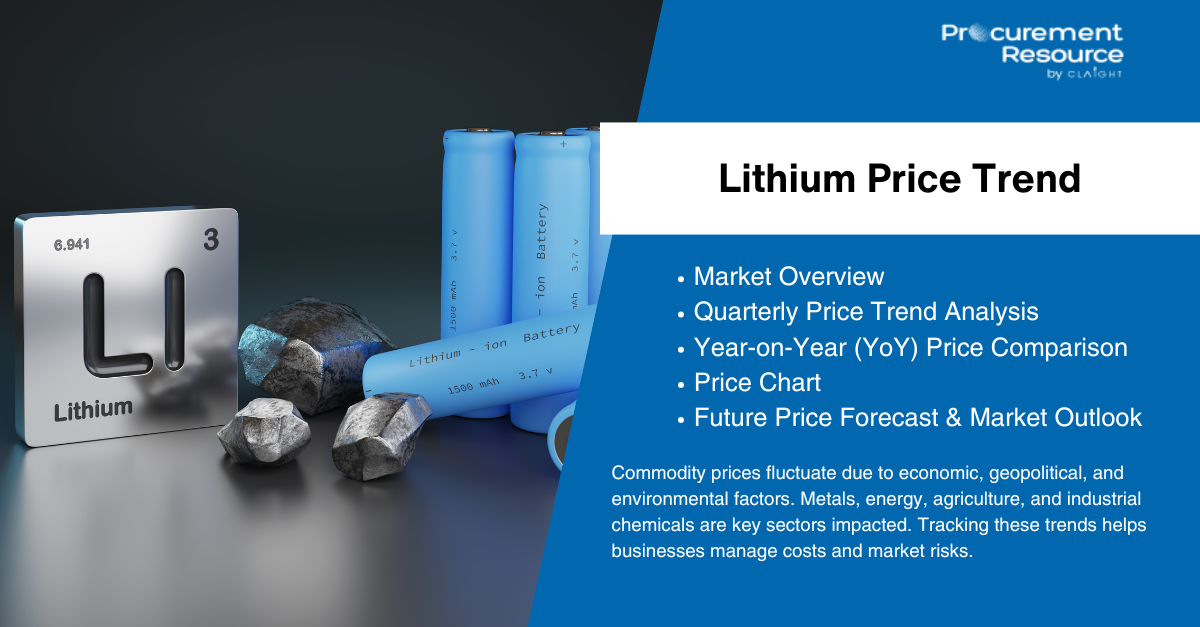The global Lithium Price Trend has become a critical focus for industries navigating the green energy transition. With demand accelerating due to electric vehicles (EVs), grid-scale batteries, and renewable energy systems, lithium’s value chain—from extraction to final application—has seen unprecedented disruption and transformation.
In this in-depth article, we explore lithium prices dynamics, market insights, historical data, price forecasts, procurement strategies, and regional breakdowns to help stakeholders make informed sourcing and investment decisions.
Lithium Market Overview: A Strategic Mineral in a Low-Carbon Future
Lithium, a lightweight alkali metal, is a cornerstone for lithium-ion batteries, the dominant energy storage technology in:
- Electric vehicles (EVs)
- Consumer electronics
- Grid-scale renewable energy storage systems
- Portable medical devices and tools
As the world rapidly shifts toward electrification, lithium’s strategic importance has soared. Governments have labeled it a critical mineral, prompting national stockpiles, investment in new supply sources, and reshoring of battery manufacturing.
Historical Data & Supply Chain Evolution
Over the past decade, lithium prices have exhibited dramatic fluctuations:
- Boom cycles driven by EV adoption surges, global policy mandates, and speculative investments
- Bust phases due to oversupply, especially during periods when new brine and hard rock projects flooded the market
- Disruptions in key producing countries (e.g., Chile, Argentina, China) caused price spikes and delivery delays
- Fluctuations in lithium carbonate and lithium hydroxide values as battery chemistries evolved
A review of historical data shows distinct pricing cycles linked to raw material bottlenecks, new technology rollouts, and regulatory changes. This underscores the importance of tracking historical lithium price data to contextualize current trends and anticipate future moves.
Lithium Price Trend: Current Status and Market Behavior
The Lithium Price Trend in recent years reflects both structural and cyclical drivers:
Structural Drivers:
- EV and energy storage growth are transforming long-term demand projections
- Battery chemistry innovation (e.g., LFP vs NMC) changes demand composition for lithium derivatives
- Government incentives and emission reduction policies are permanently altering global energy and transportation frameworks
Cyclical Influences:
- Mining output ramp-ups leading to temporary oversupply
- Inventory corrections by battery and auto manufacturers
- Slowdowns in EV sales or changes in subsidies
Short-term corrections or downturns in prices should be viewed within the larger context of a long-term demand uptrend. Strategic sourcing professionals must balance immediate market conditions with macroeconomic and policy-driven signals.
Request for the real time prices:- https://www.procurementresource.com/resource-center/lithium-price-trends/pricerequest
Market Forecast: What’s Next for Lithium?
Industry analysts predict lithium demand will continue to outpace supply over the next decade. However, pricing will remain volatile due to:
- Unpredictable ramp-up timelines for new mines and refineries
- Environmental permitting and water usage restrictions in key regions
- Global battery manufacturing shifts toward North America and Europe
- Substitution and recycling technologies impacting primary demand
While long-term prices are forecasted to remain elevated due to strong fundamentals, short-term corrections are expected as production normalizes and speculative excesses unwind. This duality calls for robust procurement strategies anchored in real-time data and long-range forecasting.
Regional Insights: A Global Tug-of-War
South America (The Lithium Triangle)
Argentina, Chile, and Bolivia collectively hold over half of the world’s known lithium reserves. Known as the “Lithium Triangle,” this region produces lithium primarily via brine extraction, which is cost-effective but environmentally sensitive. Political instability and regulatory uncertainty have added supply-side risks.
Australia
As the world’s largest producer, Australia leads in spodumene mining (a hard rock lithium source). Australian supply is critical for feeding refiners in China and, increasingly, North America and Europe. Currency movements, labor availability, and port infrastructure influence pricing in this region.
China
China dominates lithium refining and battery manufacturing, making it central to the lithium supply chain. Domestic demand fluctuations, policy shifts, and environmental regulations directly impact the global lithium price forecast. China also actively sources lithium from Africa and Latin America.
North America
The U.S. and Canada are investing heavily in domestic lithium production, supported by policy incentives like the Inflation Reduction Act. However, most projects remain in development stages, with timelines extending into the late 2020s. North American prices are also shaped by midstream investments in battery manufacturing and strategic stockpiling.
Europe
Europe is rapidly building out battery gigafactories and EV manufacturing hubs. However, its lithium supply is almost entirely imported. New projects in Portugal and Germany aim to fill the gap, but environmental opposition and slow permitting create uncertainty.
Price Charting, Database Access, and Forecasting Tools
Market participants increasingly rely on lithium price databases and visualization tools to support:
- Trend analysis
- Long-term price forecasting
- Inventory planning
- Supplier benchmarking
- Scenario modeling for contract negotiations
These tools often include price charts covering lithium carbonate, lithium hydroxide, and spodumene concentrate, with regional granularity (e.g., CIF China, ex-works Australia). Exportable data formats allow deeper analysis across procurement teams.
Role of Procurement Resource in Sourcing Strategy
Engaging a reliable procurement resource is essential in a market as volatile as lithium. These platforms and partners provide:
- Verified supplier data and pricing intelligence
- Benchmarking tools
- Custom forecasts based on consumption profile
- Alerts on geopolitical or logistical disruptions
By integrating procurement intelligence into sourcing workflows, companies can anticipate price swings, identify cost-saving opportunities, and align their purchasing with internal ESG and sustainability goals.
Procurement professionals also benefit from:
- Contract structuring strategies based on forecasted lithium cycles
- Diversification models to reduce supplier concentration risk
- Spot vs. long-term agreement modeling based on historical volatility
Contact Information
Company Name: Procurement Resource
Contact Person: Ashish Sharma (Sales Representative)
Email: sales@procurementresource.com
Location: 30 North Gould Street, Sheridan, WY 82801, USA
Phone:
UK: +44 7537171117
USA: +1 307 363 1045
Asia-Pacific (APAC): +91 1203185500
Related Reads
- Custom Fitness App Development: Build the Fitness App Your Users Actually Want
- Data-Driven Financial Advice Report Writing Best Practices For UK Firms
- How to Choose a Reliable Electronics Manufacturing Service (EMS) Provider in Illinois
- Top Asphalt Contractors | Trusted Paving Experts Near You
- Drip Too Real: New Suicideboys Gear Fashion Trend Suicide Boys Merch
- The Ultimate Guide to Choosing the Perfect Work Laptop



